
VFX supervisor Jessica Norman describes how MPC’s team created and animated vicious crowds of zombies rampaging into Jerusalem in ‘World War Z’.
WORLD WAR Z - Crowd Source |
|
Part 1 of Digital Media World'stwo-part featureon the VFX of 'World War Z' |
|
MPC's first involvement began in early 2011. MPC’s VFX supervisor Jessica Norman carried out on-set supervision mainly at the Malta shoot location, which was to stand in for scenes in the story unfolding in Jerusalem in Israel. This footage became the basis for some of the most violent, complex crowds seen in the film, in which frantic zombies pile themselves into massive pyramid mounds, tentacles and other shapes, overturn a bus and turn the streets to chaos. From Form into ActionFollowing the rapid world-wide spread of an infection that transforms people into vicious, emaciated zombies with a voracious appetite for human beings, the story follows lead character, Gerry Lane, to Jerusalem where a ‘safe’ zone called Busland has been established within a concrete barrier wall. But shortly after he arrives, the zombies outside manage to breach the wall - and havoc breaks loose. |
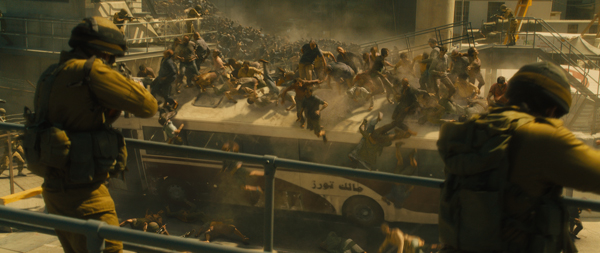 |
 |
|
To help the team understand the scale, size and overall impact the zombie masses were to have within the live action plates, MPC received some concept work from the Art Department, mainly as sketches showing essentially what they did achieve in the end. In particular, the team achieved a very effective way of animating the individuals to collect themselves into the giant mounds and hanging tentacles. However, much of the challenge came from translating the formation of those shapes into an action sequence. Insect references and schooling fish helped suggest appropriate movement, while animation supervisor Gabrielle Zucchelli and crowd lead Marco Carboni worked together on the animations required to form the zombie crowds. Early in production they captured numerous action clips as a motion capture base for specific scenes. For the piles and mounds, actors would climb up nets, for example, and for the bus sequence they scrambled up and fell over a ramp. Their moves and actions were then used to populate the crowd, starting off by defining the final shape with geometry or a shot layout, always bearing in mind the speed the animations should have as well. |
 |
 |
|
 |
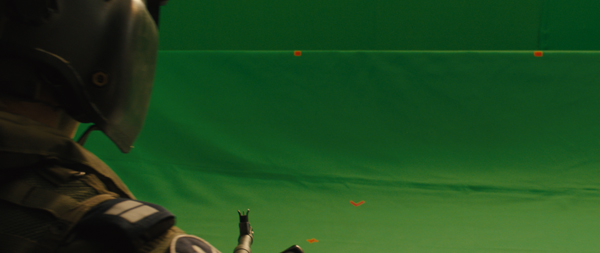 |
|
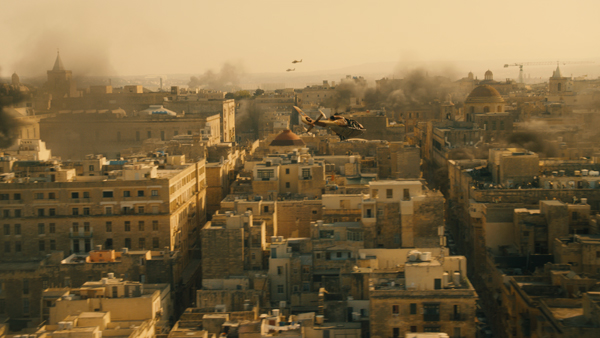 |
 |
|
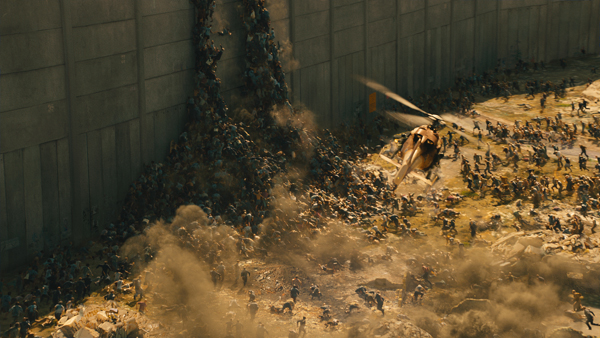 |
|
“Otherwise it became very hard to sort out different layers within, say, a pyramid of zombies, and then work out how to render and release these layers. The larger pyramids were usually made up of about 5,000 agents. To be able to render these scenes, we split the crowd into many layers, a complex process because the agents are all interacting. Sometimes, zombies would start behind other zombies, and end up in front or fall on top of other zombies. “With traditional holdout passes we would have had to re-render most layers and holdouts if we wanted to change one or a few zombies. The matting or cookie cutting would not have been correct, as the holdout pass only is relevant to the exact position all the zombies were at when it was rendered and assumes that they all are there. Deep Passes“With deep passes, you have the information about each agent’s position in space that you can use to matte different agents or objects against each other without having to re-render every layer or the holdout. During shot production we would often want to change the animation of one or a group of zombies, or maybe remove a few. Using deep passes created a more flexible workflow were we could change the animation on a few zombies without the heavy rendering of all passes. At times, we ended up pre-compositing all the layers, maintaining the various AOVs within, to produce one large, combined crowd.” Jessica pointed out that the different departments at MPC always try to align their work closely together, but it was particularly important on WWZ. The team work and work in between departments was invaluable and helped piece all the different aspects of zombies and zombie crowds together – the crowd and animation teams working on behaviours, for example, and the lighting, crowd and compositing teams planning for the render. |
 |
  |
|
Busland BarrierMPC’s team built the 70ft high wall surrounding Busland as a digital piece, securing the neighbourhood from zombie invasion and infection. The wall asset was represented on set by smaller, practical pieces positioned where they needed to attach visibly to the set. MPC extended this out and added scaled sections to the tops of buildings, a solid featureless concrete barrier made to look like a newly built structure. The team also surrounded one of the main shoot locations in Malta with a digital environment comprising a margin of wasteland with a backdrop representing Jerusalem, seen from a distance. This Jerusalem environment was a 2.5D matte painting projection based on photography. The scenes shot at this location included large numbers of extras for the humans, which MPC developed as more typical crowd shots by filling in with denser, combined human and zombie crowds. Runway ChaosMPC has worked on many realistic airport and aircraft sequences but the scene at the airport out of Israel needed to express panic and chaos, not controlled take-offs and landings. Numerous types of planes all rushed to the runway at once, abandoning most safety procedures. “The scene was shot at a small airport in Malta. We added a terminal building using 2.5D matte paintings and also slightly changed the layout of the runways to work in the movie,” said Jessica. “Our environment team added a city in the distance with smoke and fire elements in the composite. |
 |
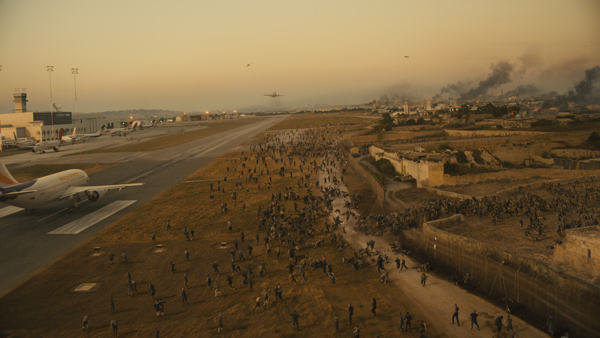 |
|
Crash LandingOnce the lead character Gerry Lane manages to get away in a passenger plane, he discovers that zombies have boarded with them and begun to attack the crew. As they advance on the passengers, he is forced to throw a grenade through the side of the plane, hoping the zombies will be swept out. Blasting the hole through the set was achieved as a practical effect by the special effects team and shot with several cameras to provide enough angles for the post work. It was tricky for MPC and the camera crew to know in advance how people should be placed in this shot. In fact, most of the individuals seen right at the moment of explosion were digital, seen getting sucked out of the aircraft combined with a few stunt actors pulled out on wires. Green screen placed behind windows and, later, the hole itself was replaced with aerial footage from Israel during take-off, and then from Wales as the plane comes in for a crash landing resulting in a broken engine, wing and nose. |
 |
 |
|
“Once the plane animation blocking was approved we started looking at the trees in the plate and worked out which parts of the live action element that we would replace with CG trees and matte painted background. We added additional trees closer to camera than what originally was in the plate to help create depth in the shot and elements for the plane to interact with.” Zombies Up CloseJust before rushing onto the plane, Gerry cuts off the young Israeli soldier Segen’s hand to prevent the spread of infection from a zombie’s bite. In the following shots on board, the actress wears a blue sock over her hand, which was painted out and replaced with a CG bandaged placed over the end of her shortened arm. At the WHO installation we get a view of individual zombies at close range and moving quite slowly. Here, the performances were shot in-camera and the actors wore prosthetic make-up. MPC helped enhance their make-up and retimed a few of the moves to accentuate their strangeness, but Jessica said their looks and performances were excellent and essentially caught live. The team also added video inserts to the building’s many security monitors.ww.moving-picture.com |
| Words: Adriene Hurst Images: Courtesy of Paramount Pictures |


















